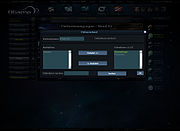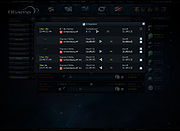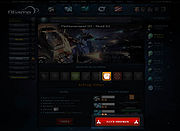Difference between revisions of "Tutorial:ACS"
Francolino (Talk | contribs) |
|||
| (3 intermediate revisions by 3 users not shown) | |||
| Line 6: | Line 6: | ||
{{Screenshot|ACS|A}} | {{Screenshot|ACS|A}} | ||
| − | To start an ACS-attack, one of the players first has to begin an attack with a fleet. As soon as it flies, he can change that fleet to a union and invite other players via the fleet menu, whereat those don't have to be in the alliance or on the buddy list. Those players will get an invitation for the union and will be able to join the attack with their fleets via clicking on the short link on the second fleet page ("Combat forces"). All in all, five players can join in the union combat; the union fleet can consist of a maximum 16 fleets, altogether. But look out; all fleets of a union are geared to the slowest one. So, if a slower fleet is added to a union, the arrival time of all fleets will be set back. That can also be leveraged as the chapter {{Link| | + | To start an ACS-attack, one of the players first has to begin an attack with a fleet. As soon as it flies, he can change that fleet to a union and invite other players via the fleet menu, whereat those don't have to be in the alliance or on the buddy list. Those players will get an invitation for the union and will be able to join the attack with their fleets via clicking on the short link on the second fleet page ("Combat forces"). All in all, five players can join in the union combat; the union fleet can consist of a maximum 16 fleets, altogether. But look out; all fleets of a union are geared to the slowest one. So, if a slower fleet is added to a union, the arrival time of all fleets will be set back. That can also be leveraged as the chapter {{Link|Tactic:Slowdown by ACS}} will show. |
{{Screenshot|ACS|B}} | {{Screenshot|ACS|B}} | ||
| − | If a fleet is more than 30 % slower as the union, it will not be able to join. First of all if it is about an interception, at which it is important that the fleet union arrives exactly at the right time, the ACS-attack should be arranged accordingly. It will be the best, if the player, who has the longest approach, starts it. All the others can send their fleets, without reducing speed of the first fleet. At interceptions you also can save deuterium by timing with a single ship at first, and after that joining the combat fleet. Like that, if you have timed the attack in a wrong way, you will have to call back only one ship and not sending the whole fleet twice. You especially will have to pay attention, if the attack is | + | If a fleet is more than 30 % slower as the union, it will not be able to join. First of all if it is about an interception, at which it is important that the fleet union arrives exactly at the right time, the ACS-attack should be arranged accordingly. It will be the best, if the player, who has the longest approach, starts it. All the others can send their fleets, without reducing speed of the first fleet. At interceptions you also can save deuterium by timing with a single ship at first, and after that joining the combat fleet. Like that, if you have timed the attack in a wrong way, you will have to call back only one ship and not sending the whole fleet twice. You especially will have to pay attention, if the attack is cancelled. In that case, every player has to call back his own fleet manually – if only one fleet cancels the flight, the rest of the union will just continue. If the fleet, which starts the union, is called back, no other fleets will be able to join the union. |
{{Style-FloatOff}} | {{Style-FloatOff}} | ||
| Line 15: | Line 15: | ||
{{Screenshot|ACS|C}} | {{Screenshot|ACS|C}} | ||
| − | With a union you can surprise an enemy not only with an attack, but also with a defense. If you want to defend a planet of a member of the alliance or of a buddy, you just will have to command your fleet there and to choose the mission "hold". Before sending your fleet, you will be able to specify how long it shall stay at the target. As long as it is deployed there, it will participate in every combat | + | With a union you can surprise an enemy not only with an attack, but also with a defense. If you want to defend a planet of a member of the alliance or of a buddy, you just will have to command your fleet there and to choose the mission "hold". Before sending your fleet, you will be able to specify how long it shall stay at the target. As long as it is deployed there, it will participate in every combat in line with the defender, if the moon or planet is attacked, but whose owner cannot control it himself. But during this time, the fleet constantly needs deuterium, that is why the holding time is limited by the cargo bay of the fleet. If you want to fly back earlier as it was planed, you will only have to click on call back in the fleet menu, to cancel the holding operation. A maximum four players are able to hold on a foreign planet / moon; all in all 15 fleets are possible. |
But look out; if you attack a planet or a moon, on which one of your fleets is holding, your fleets will fight against each other. | But look out; if you attack a planet or a moon, on which one of your fleets is holding, your fleets will fight against each other. | ||
Latest revision as of 03:17, 5 January 2012
The Alliance Combat System (ACS) permits fighting together with other players, so that no player is always on his own. On the one hand thereby you can attack a target with friends, and on the other hand you also can deploy your fleet for defense at alliance partners or at players, who are on your buddy list. Thus you cannot only attack significantly bigger targets, but also a few important tactical alternatives are due to it.
How to attack together ?
To start an ACS-attack, one of the players first has to begin an attack with a fleet. As soon as it flies, he can change that fleet to a union and invite other players via the fleet menu, whereat those don't have to be in the alliance or on the buddy list. Those players will get an invitation for the union and will be able to join the attack with their fleets via clicking on the short link on the second fleet page ("Combat forces"). All in all, five players can join in the union combat; the union fleet can consist of a maximum 16 fleets, altogether. But look out; all fleets of a union are geared to the slowest one. So, if a slower fleet is added to a union, the arrival time of all fleets will be set back. That can also be leveraged as the chapter Slowdown by ACS will show.
If a fleet is more than 30 % slower as the union, it will not be able to join. First of all if it is about an interception, at which it is important that the fleet union arrives exactly at the right time, the ACS-attack should be arranged accordingly. It will be the best, if the player, who has the longest approach, starts it. All the others can send their fleets, without reducing speed of the first fleet. At interceptions you also can save deuterium by timing with a single ship at first, and after that joining the combat fleet. Like that, if you have timed the attack in a wrong way, you will have to call back only one ship and not sending the whole fleet twice. You especially will have to pay attention, if the attack is cancelled. In that case, every player has to call back his own fleet manually – if only one fleet cancels the flight, the rest of the union will just continue. If the fleet, which starts the union, is called back, no other fleets will be able to join the union.
Defending together
With a union you can surprise an enemy not only with an attack, but also with a defense. If you want to defend a planet of a member of the alliance or of a buddy, you just will have to command your fleet there and to choose the mission "hold". Before sending your fleet, you will be able to specify how long it shall stay at the target. As long as it is deployed there, it will participate in every combat in line with the defender, if the moon or planet is attacked, but whose owner cannot control it himself. But during this time, the fleet constantly needs deuterium, that is why the holding time is limited by the cargo bay of the fleet. If you want to fly back earlier as it was planed, you will only have to click on call back in the fleet menu, to cancel the holding operation. A maximum four players are able to hold on a foreign planet / moon; all in all 15 fleets are possible.
But look out; if you attack a planet or a moon, on which one of your fleets is holding, your fleets will fight against each other.
The conjoint defending is perfect, when a member of the alliance is attacked by an adverse player. Here, with a little bit luck, you can deploy your fleet on the target before the attacker arrives and thus surprise him. If the own fleet arrives a few seconds before the attacker’s one, he suddenly will be face to face with an unforeseen superiority and loose his own fleet, instead of abolishing the fleet of your alliance partner.
What use does the alliance depot have ?
The alliance depot acts as a deuterium supply for your fleet while it is defending a planet or a moon, so that it can stay there longer. For this you choose the alliance depot at the facility menu on the accordant planet and you enter the amount of deuterium, which shall be send to the fleet and affirm the process. The bigger the depot, the more deuterium you can send per hour like that. That facility proves unusable, because in practice you normally do not hold your fleet on a foreign planet more than one hour. So you can confidently save the time and the resource, which you need for the construction.




